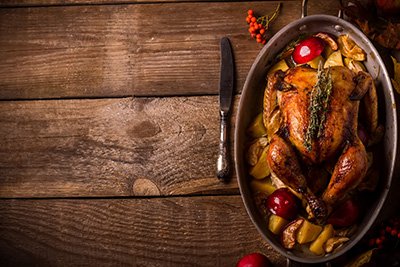The day after Thanksgiving is the second-busiest day of the year for urgent care clinics (the day after Christmas is the busiest). 47% more people than average come in with gastrointestinal issues, many of which could have been prevented with proper food handling and cooking. The turkey is often the culprit. Follow these tips to safely prepare your turkey this Thanksgiving.
- Safely Thaw Your Turkey. Turkeys should never be thawed simply by leaving out on the counter. Instead, thaw your turkey in the refrigerator, in a sink of cold water changed every 30 minutes, or in the microwave. Frozen turkeys are indefinitely safe, but thawing turkeys must defrost at a safe temperature. If a turkey is left out at room temperature for more than two hours, bacteria can grow rapidly. The danger zone for bacteria growth is between 40°F and 140°F.
- Safely Handle Your Turkey. Bacteria from raw poultry can contaminate anything it touches. Follow the four food safety steps from the CDC to prevent the spread of bacteria. a. Clean – Wash hands and cooking surfaces often. Wash hands for 20 seconds before, during, and after preparing food. Wash utensils, cutting boards, and utensils in hot, soapy water.b. Separate – Germ from raw poultry, eggs, and other meats can easily spread germs to ready-to-eat foods. Use separate cutting boards, knives, and plates when preparing food. Store them separately in the refrigerator.c. Cook – Food must be cooked to an internal temperature that is high enough to kill germs. The only way to ensure that meat is safe to eat is by using a food thermometer. Checking color and temperature is not enough. Cook your turkey (and any casseroles or leftovers) until the internal temperature reaches 165°F.
- Safely Stuff Your Turkey. Stuffing, or “dressing”, should be cooked in a casserole dish to an internal temperature of 165°F – use a food thermometer to check. Mix wet and dry ingredients together immediately before cooking – don’t make it in advance. If you cook your stuffing inside the turkey, remove the bird from the oven and let it stand for 20 minutes before removing.
- Safely Cook Your Turkey – Set the oven temperature to at least 325°F. Place the completely thawed turkey breast-side up in a roasting pan at least 2 inches deep. Cooking time will vary depending on the turkey’s weight. To make sure the turkey has reached a safe internal temperature of 165°F, check by inserting a food thermometer into the thickest portions of the breast, thigh, and wing joint. If you’re cooking stuffing inside your turkey, check the temperature of the stuffing as well. If you’re deep-frying your turkey, always cook outside, read the manual, and keep children and pets far away from the fryer.
- Take Care with Leftovers. Refrigerate leftovers promptly. Bacteria multiply rapidly at room temperature and between 40°F and 140°F. Always throw away perishable food left out more than two hours.
Integrity Urgent Care wishes you and your family a safe and happy Thanksgiving! We will be closed Thanksgiving Day, but will be open during regular hours, 8 a.m. – 8 p.m., the rest of the week.


